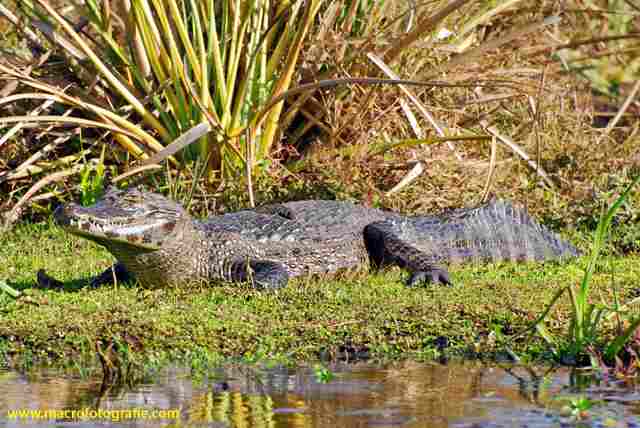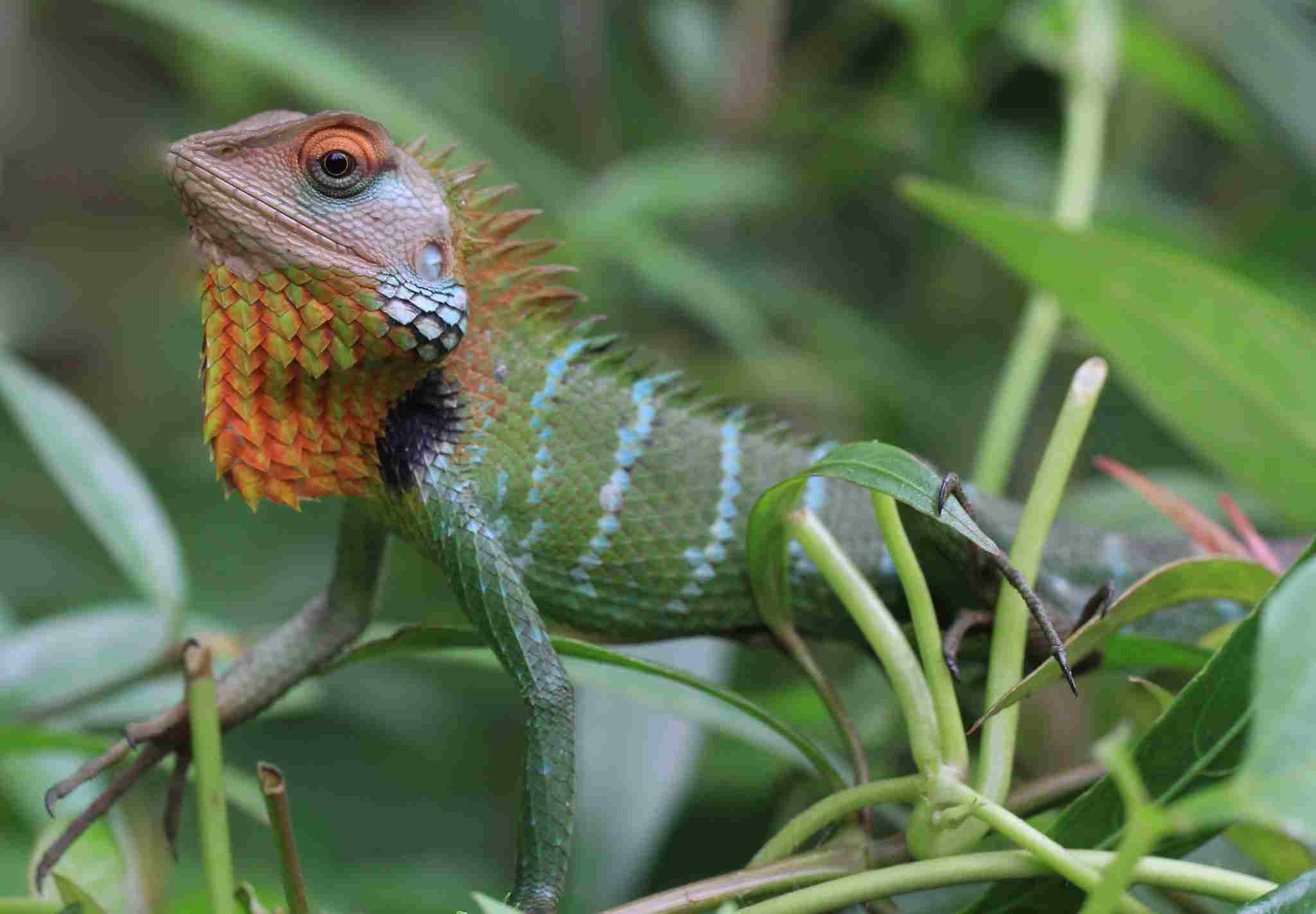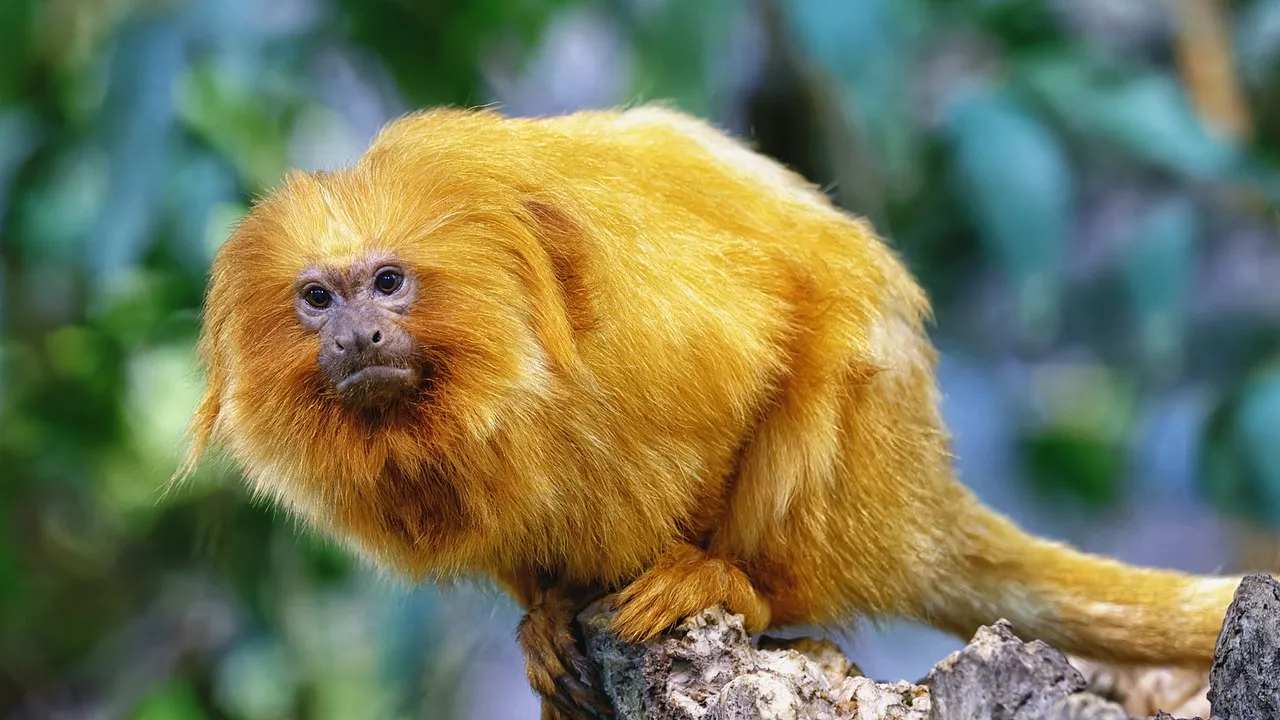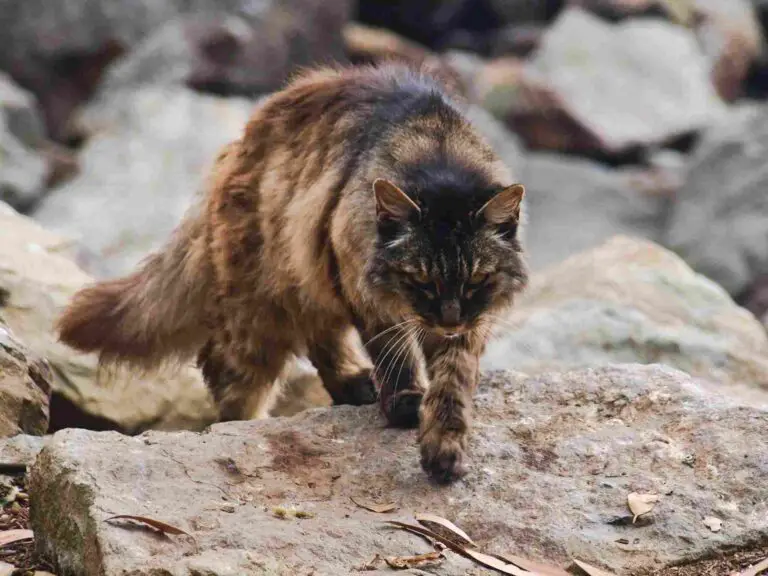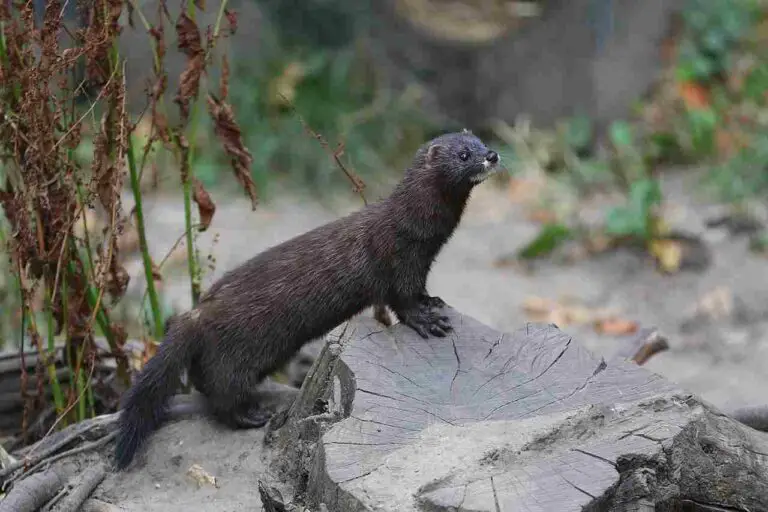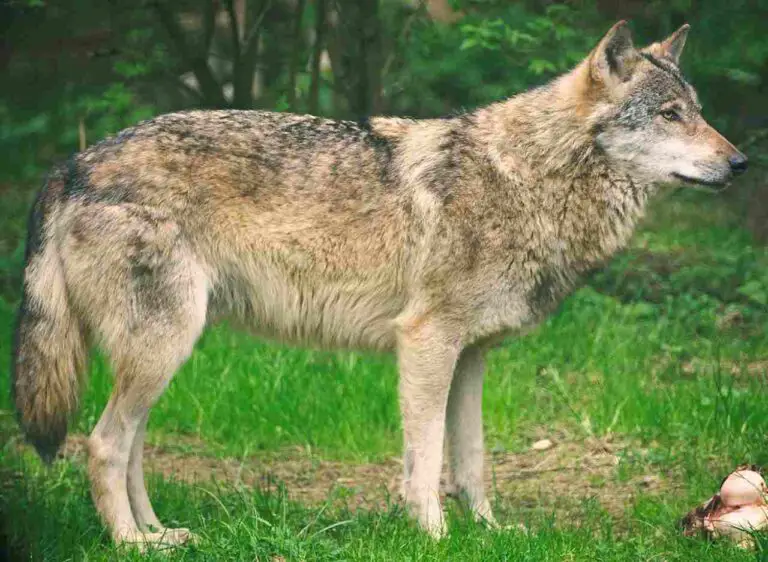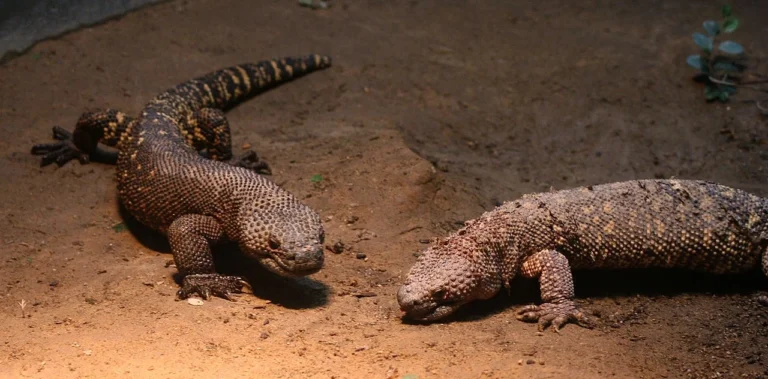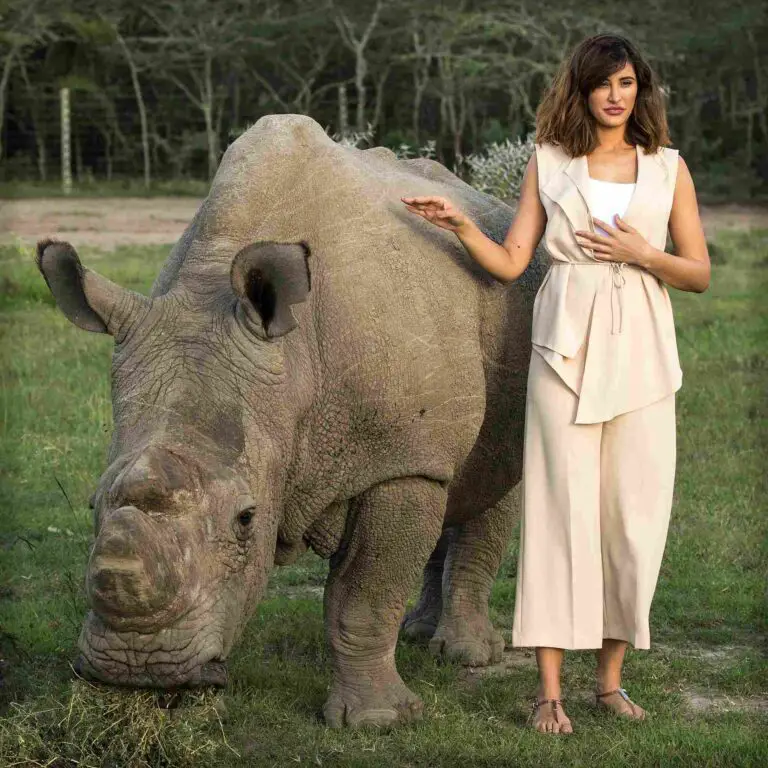7+ Secondary Consumers in the Tropical Rainforest Discussed
Secondary consumers in the tropical rainforest are diverse and play vital roles in maintaining ecosystem balance. These include the ocelot, civet, lizard, snake, spider monkey, frog, spider, vampire bat, and owl. Each species has unique adaptations for hunting and feeding, contributing to the regulation of prey populations and the flow of energy and nutrients through the rainforest food web. Threats such as habitat loss, hunting, and climate change endanger these secondary consumers, emphasizing the importance of conservation efforts to protect rainforest biodiversity.
1. Ocelot
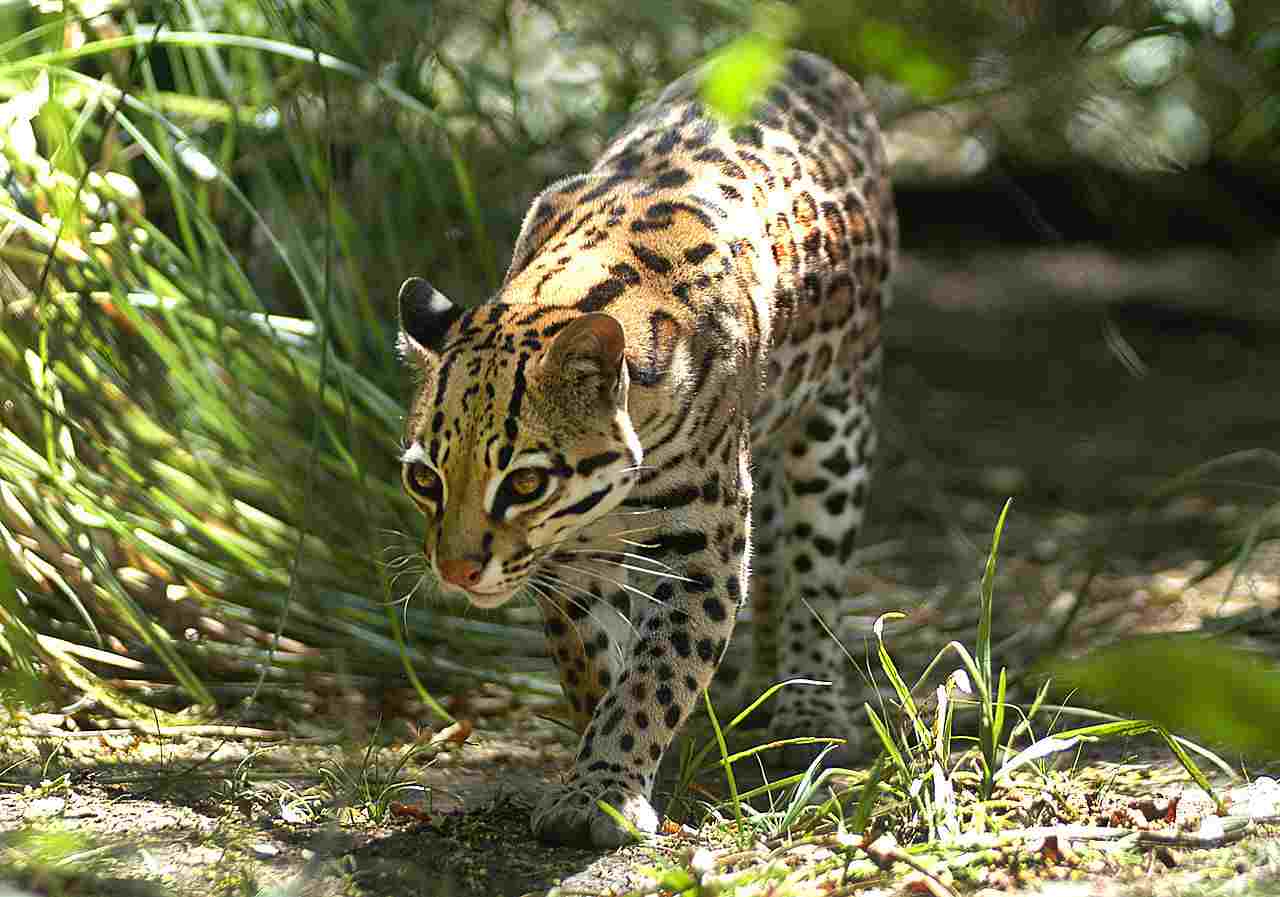
Habitat and Distribution: Ocelots (Leopardus pardalis) are medium-sized wild cats native to the tropical rainforests of Central and South America, ranging from Mexico to Argentina. They inhabit a variety of ecosystems within the rainforest, including dense jungles, swamps, and mangrove forests.
Physical Characteristics: Ocelots are known for their striking appearance, characterized by a sleek, tawny coat marked with black rosettes and stripes. Their fur helps them blend seamlessly into the dappled sunlight and shadows of the rainforest canopy. They have short legs, a long tail, and distinctive, expressive facial features, including large, round eyes and prominent whiskers.
Diet and Feeding Habits: As secondary consumers in the rainforest ecosystem, ocelots primarily prey on smaller animals, serving as important regulators of prey populations. Their diet consists mainly of small to medium-sized mammals, such as rodents, rabbits, birds, and reptiles. They are also known to hunt larger prey, including monkeys and young deer, utilizing their keen senses of sight and hearing to ambush their targets with stealth and precision.
Behavior and Hunting Strategy: Ocelots are solitary and nocturnal hunters, preferring to hunt under the cover of darkness when their prey is most active. They are highly adaptable predators, capable of stalking their quarry through dense vegetation or climbing trees with agility and grace. Their retractable claws and powerful jaws enable them to swiftly dispatch their prey with a bite to the neck or skull.
Role in the Ecosystem: As apex predators within their habitat, ocelots play a crucial role in maintaining the balance of the rainforest ecosystem. By controlling the populations of smaller animals, they help prevent overgrazing and maintain the health of plant communities. Additionally, they contribute to the regulation of prey species, which in turn affects the distribution and abundance of other organisms within the food web.
Conservation Status: Despite their importance to the ecosystem, ocelot populations face various threats, including habitat loss, fragmentation, and poaching for their fur. As a result, they are classified as a species of “Least Concern” on the IUCN Red List; however, continued conservation efforts are necessary to ensure their long-term survival in the wild.
Interactions with Humans: Ocelots have long been admired for their beauty and grace, but their elusive nature and nocturnal habits make them rarely seen by humans in the wild. Nevertheless, they are occasionally targeted by hunters for their fur or persecuted by farmers who view them as threats to livestock. Efforts to mitigate human-wildlife conflicts and protect ocelot habitats are essential for their conservation and the preservation of tropical rainforest ecosystems.
2. Civet
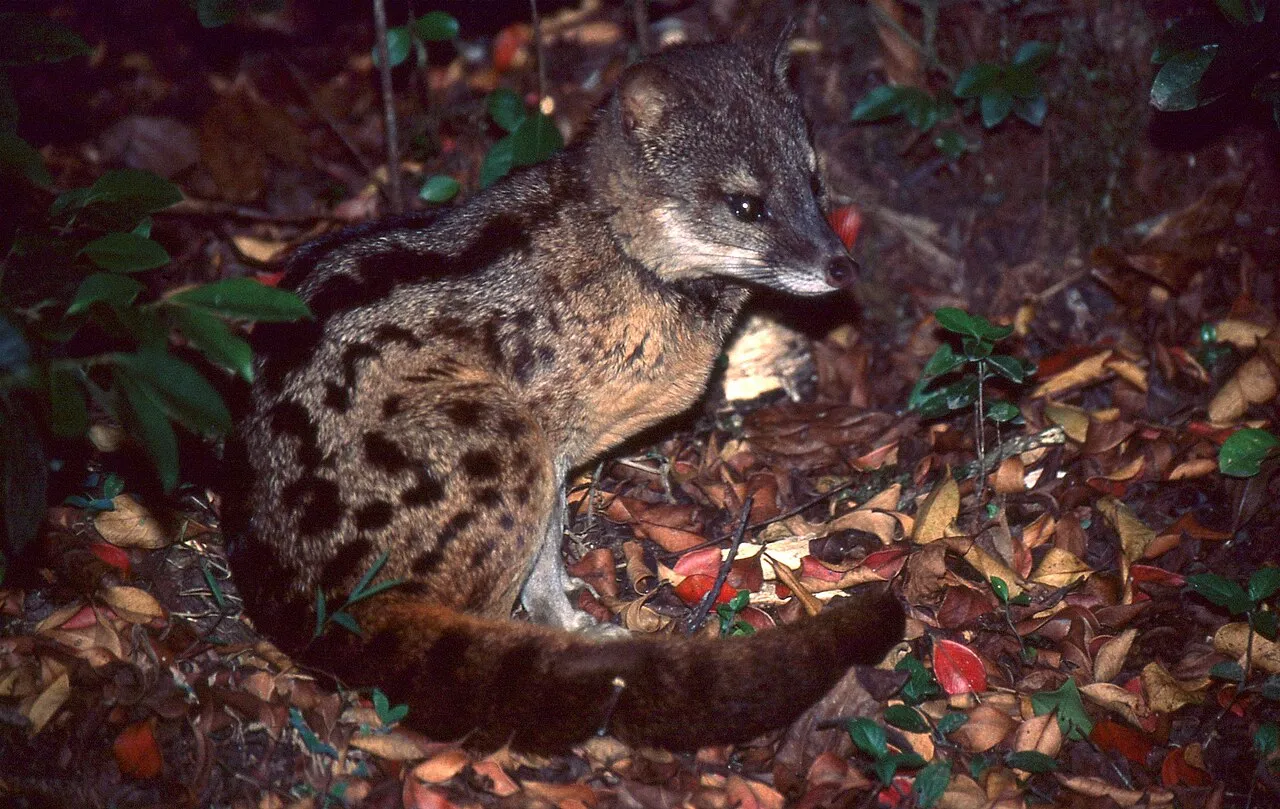
Habitat and Distribution: Civets, belonging to the family Viverridae, are small to medium-sized mammals found in tropical rainforests across Africa and Asia. They inhabit a wide range of forested habitats, including lowland rainforests, montane forests, and secondary growth forests.
Physical Characteristics: Civets are characterized by their long, slender bodies, short legs, and distinctive facial markings. They have a pointed muzzle, large ears, and a long, bushy tail. Most species have a dark coat with spots, stripes, or other patterns that help them blend into their forest environment.
Diet and Feeding Habits: As omnivores, civets have a varied diet consisting of fruits, insects, small mammals, birds, reptiles, and eggs. They are particularly known for their ability to digest coffee cherries, a process that contributes to the production of “civet coffee,” a sought-after delicacy. Civets play an important role in seed dispersal, as they consume a wide variety of fruits and help spread the seeds through their feces.
Behavior and Hunting Strategy: Civets are primarily nocturnal animals, although some species may also be active during the day. They are skilled climbers and spend much of their time in the trees, where they forage for food and seek shelter from predators. Civets have a keen sense of smell and use their long, flexible snouts to locate prey hidden in the forest understory.
Role in the Ecosystem: As secondary consumers, civets occupy a crucial niche in the rainforest food web. By preying on small animals and consuming fruits, they help regulate populations of insects and contribute to the dispersal of seeds, which promotes forest regeneration and biodiversity. Civets also serve as prey for larger predators, such as snakes, birds of prey, and large carnivores.
Conservation Status: Several species of civets are threatened by habitat loss, deforestation, and hunting for their meat, fur, and glands. The Asian palm civet (Paradoxurus hermaphroditus), in particular, has been heavily exploited for the production of civet coffee, leading to concerns about its conservation status. Conservation efforts focused on habitat protection and sustainable harvesting practices are essential for the long-term survival of civets in the wild.
Interactions with Humans: Civets have a complex relationship with humans, as they are both admired for their role in ecosystem functioning and exploited for economic gain. In some cultures, civets are revered as symbols of good luck or spiritual significance, while in others, they are hunted for their meat or captured for the illegal pet trade. Efforts to raise awareness about the importance of civets in maintaining healthy ecosystems and promote sustainable coexistence with these animals are crucial for their conservation.
3. Lizard
Habitat and Distribution: Lizards are a diverse group of reptiles found in tropical rainforests worldwide, occupying a variety of microhabitats, including trees, leaf litter, and rocky outcrops. They are particularly abundant in warm, humid environments with ample vegetation and prey resources.
Physical Characteristics: Lizards exhibit a wide range of body shapes, sizes, and coloration patterns, reflecting their adaptability to different habitats and ecological niches. They have elongated bodies, long tails, and four legs equipped with sharp claws for climbing and grasping. Many species are equipped with camouflage or warning coloration to avoid predation or attract mates.
Diet and Feeding Habits: As ectothermic predators, lizards rely on external sources of heat to regulate their body temperature and energy metabolism. They are opportunistic feeders, consuming a diverse array of prey, including insects, spiders, small vertebrates, and plant material. Some larger species of lizards, such as monitor lizards, are capable of preying on birds, mammals, and even other reptiles.
Behavior and Hunting Strategy: Lizards exhibit a wide range of behaviors and hunting strategies, depending on their size, diet, and habitat. Arboreal species may stalk prey among the branches of trees, using their keen eyesight and agility to catch insects or small vertebrates. Ground-dwelling lizards may forage for food among leaf litter or rocks, relying on stealth and ambush to capture prey.
Role in the Ecosystem: As secondary consumers, lizards play a vital role in regulating populations of insects and other invertebrates, which are important components of the rainforest food web. By preying on herbivorous insects and serving as prey for larger predators, lizards help maintain the balance of the ecosystem and promote biodiversity. Some species of lizards also contribute to seed dispersal through their consumption of fruits and berries.
Conservation Status: Many species of lizards are threatened by habitat destruction, climate change, pollution, and invasive species. Deforestation and land conversion for agriculture, logging, and urban development pose significant threats to lizard populations, particularly in tropical regions where rainforests are rapidly disappearing. Conservation efforts focused on habitat protection, captive breeding, and reintroduction programs are essential for the long-term survival of endangered lizard species.
4. Snake
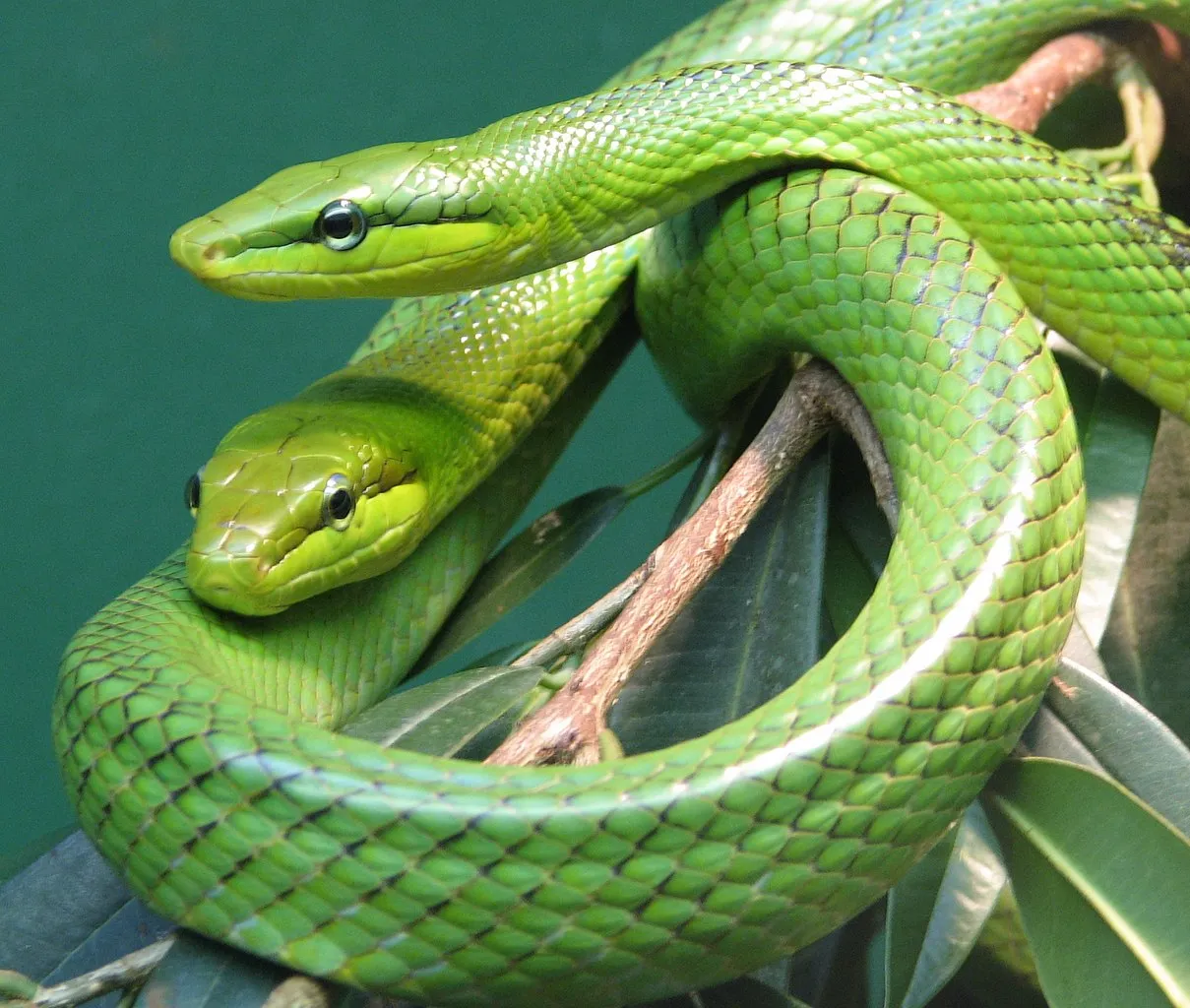
Habitat and Distribution: Snakes are a diverse group of reptiles found in tropical rainforests around the world, inhabiting a variety of terrestrial and arboreal habitats. They are particularly abundant in warm, humid environments with dense vegetation and ample prey resources.
Physical Characteristics: Snakes exhibit a wide range of body shapes, sizes, and coloration patterns, reflecting their adaptation to different habitats and ecological niches. They lack limbs and ear openings, with elongated bodies covered in scales that help reduce friction and aid in movement. Some species have specialized features such as heat-sensing pits or venomous fangs for hunting and defense.
Diet and Feeding Habits: As carnivorous predators, snakes feed primarily on a diet of rodents, birds, amphibians, reptiles, and invertebrates. They are skilled hunters, using a combination of stealth, ambush, and constriction to capture and subdue their prey. Venomous snakes inject toxic venom into their prey through specialized fangs, while non-venomous snakes rely on powerful jaws to overpower and swallow their prey whole.
Behavior and Hunting Strategy: Snakes exhibit a variety of hunting strategies depending on their species, size, and habitat. Arboreal snakes may lie in wait on tree branches, using camouflage and patience to ambush passing prey. Ground-dwelling snakes may actively search for food among leaf litter or burrow into the soil to locate prey hiding underground. Some species of snakes are nocturnal, while others are diurnal or crepuscular, depending on their preferred prey and environmental conditions.
Role in the Ecosystem: As secondary consumers, snakes play a crucial role in regulating populations of prey species, including rodents, insects, and small vertebrates. By controlling the abundance of prey, snakes help maintain the balance of the rainforest ecosystem and prevent overgrazing or herbivory that could disrupt plant communities. Snakes also serve as prey for larger predators such as birds of prey, mammals, and other reptiles, contributing to the complexity and interconnectedness of the food web.
Conservation Status: Many species of snakes are threatened by habitat loss, fragmentation, pollution, climate change, and persecution by humans. Deforestation and land conversion for agriculture, logging, and urban development are significant threats to snake populations, particularly in tropical regions where rainforests are rapidly disappearing. Conservation efforts focused on habitat protection, sustainable land management, and education about the importance of snakes in ecosystem functioning are essential for their long-term survival.
5. Spider Monkey
Habitat and Distribution: Spider monkeys are large arboreal primates found in the tropical rainforests of Central and South America. They inhabit a variety of forested habitats, including lowland rainforests, montane forests, and gallery forests along rivers and streams.
Physical Characteristics: Spider monkeys are characterized by their long, slender limbs, prehensile tails, and distinctive prehensile tails, which they use to grasp branches and navigate through the forest canopy. They have a slender build, with long arms and legs adapted for swinging and climbing among the trees. Spider monkeys have a prehensile tail that is capable of supporting their entire body weight and can be used as an extra limb for grasping branches or food.
Diet and Feeding Habits: As omnivores, spider monkeys have a varied diet consisting of fruits, leaves, flowers, seeds, and insects. They are highly frugivorous, with fruits making up the majority of their diet, particularly ripe fruits rich in sugars and nutrients. Spider monkeys are important seed dispersers, as they consume a wide variety of fruits and help spread the seeds through their feces, promoting forest regeneration and biodiversity.
Behavior and Feeding Strategy: Spider monkeys are highly social animals, living in large, cohesive groups known as troops or bands. They are diurnal and spend much of their time foraging for food in the forest canopy, using their keen eyesight and agile movements to locate ripe fruits and other food sources. Spider monkeys are adept climbers and can leap large distances between branches, using their prehensile tails for balance and support.
Role in the Ecosystem: As secondary consumers, spider monkeys play a crucial role in seed dispersal and forest regeneration. By consuming a wide variety of fruits and dispersing seeds throughout the forest, they help maintain the diversity and abundance of plant species. Spider monkeys also serve as prey for large predators such as jaguars, ocelots, and birds of prey, contributing to the flow of energy and nutrients through the rainforest ecosystem.
Conservation Status: Spider monkeys are threatened by habitat loss, fragmentation, hunting, and the illegal pet trade. Deforestation and land conversion for agriculture, logging, and infrastructure development are significant threats to spider monkey populations, particularly in areas where their habitat is rapidly disappearing. Conservation efforts focused on habitat protection, law enforcement, and community-based initiatives are essential for the long-term survival of spider monkeys in the wild.
6. Frog

Habitat and Distribution: Frogs are amphibians found in tropical rainforests worldwide, inhabiting a variety of aquatic and terrestrial habitats, including ponds, streams, rivers, and forest floor. They are particularly abundant in areas with high humidity and ample water sources for breeding and development.
Physical Characteristics: Frogs exhibit a wide range of body shapes, sizes, and coloration patterns, reflecting their adaptation to different habitats and ecological niches. They have smooth, moist skin, webbed feet, and bulging eyes located on the top of their heads for enhanced vision. Many species of frogs have bright coloration or patterns that serve as warning signals to predators or help them blend into their environment.
Diet and Feeding Habits: As carnivorous predators, frogs feed primarily on a diet of insects, spiders, small invertebrates, and other small animals. They are opportunistic feeders, using their sticky tongues to capture prey with lightning-fast strikes. Some larger species of frogs may also consume small vertebrates, including fish, birds, and other frogs.
Behavior and Feeding Strategy: Frogs are ectothermic animals, relying on external sources of heat to regulate their body temperature and energy metabolism. They are primarily nocturnal or crepuscular, with many species becoming more active during the night to hunt for food. Frogs are ambush predators, lying in wait for unsuspecting prey to pass by before launching a swift attack with their tongues.
Role in the Ecosystem: As secondary consumers, frogs play a crucial role in regulating populations of insects and other invertebrates, which are important components of the rainforest food web. By preying on herbivorous insects and serving as prey for larger predators, frogs help maintain the balance of the ecosystem and prevent outbreaks of pests or diseases. Frogs also contribute to nutrient cycling through their consumption and excretion of organic matter.
Conservation Status: Many species of frogs are threatened by habitat loss, pollution, climate change, disease, and invasive species. Deforestation and land conversion for agriculture, logging, and urban development are significant threats to frog populations, particularly in tropical regions where rainforests are rapidly disappearing. Conservation efforts focused on habitat protection, captive breeding, disease management, and monitoring of wild populations are essential for the long-term survival of endangered frog species.
7. Spider
Habitat and Distribution: Spiders are arachnids found in tropical rainforests worldwide, inhabiting a wide range of microhabitats, including trees, leaf litter, soil, and caves. They are particularly abundant in areas with high humidity and ample prey resources, such as insects and other small invertebrates.
Physical Characteristics: Spiders exhibit a wide range of body shapes, sizes, and coloration patterns, reflecting their adaptation to different hunting strategies and ecological niches. They have eight legs, two body segments (cephalothorax and abdomen), and multiple eyes arranged in various configurations depending on their species. Spiders are known for their silk-producing organs, called spinnerets, which they use to build webs for trapping prey or constructing shelters.
Diet and Feeding Habits: As carnivorous predators, spiders feed primarily on a diet of insects, spiders, small invertebrates, and other small animals. They are skilled hunters, using a combination of stealth, speed, and venom to capture and subdue their prey. Most species of spiders are solitary hunters, although some may exhibit cooperative hunting behaviors or engage in communal living arrangements.
Behavior and Feeding Strategy: Spiders are ectothermic animals, relying on external sources of heat to regulate their body temperature and energy metabolism. They are primarily nocturnal or crepuscular, with many species becoming more active during the night to hunt for food. Spiders use a variety of hunting strategies, including web-building, ambush, and pursuit, depending on their species, size, and habitat.
Role in the Ecosystem: As secondary consumers, spiders play a crucial role in regulating populations of insects and other invertebrates, which are important components of the rainforest food web. By preying on herbivorous insects and serving as prey for larger predators, spiders help maintain the balance of the ecosystem and prevent outbreaks of pests or diseases. Spiders also contribute to nutrient cycling through their consumption and excretion of organic matter.
Conservation Status: Many species of spiders are threatened by habitat loss, pollution, climate change, and the use of pesticides. Deforestation and land conversion for agriculture, logging, and urban development are significant threats to spider populations, particularly in tropical regions where rainforests are rapidly disappearing. Conservation efforts focused on habitat protection, sustainable land management, and education about the importance of spiders in ecosystem functioning are essential for their long-term survival.
8. Vampire Bat
Habitat and Distribution: Vampire bats are small mammals found in tropical rainforests and other habitats throughout Central and South America. They typically inhabit areas with dense vegetation and ample roosting sites, such as caves, hollow trees, and abandoned buildings.
Physical Characteristics: Vampire bats belong to the family Phyllostomidae and are characterized by their small size, leathery wings, and specialized adaptations for feeding on blood. They have sharp incisor teeth and razor-like incisors that allow them to make small, painless incisions in the skin of their prey. Vampire bats have excellent senses of smell and hearing, which they use to locate suitable prey and navigate through their environment.
Diet and Feeding Habits: As obligate blood-feeders, vampire bats primarily feed on the blood of other animals, including mammals, birds, and occasionally reptiles. They have a specialized saliva that contains anticoagulants to prevent the blood from clotting and facilitate feeding. Vampire bats typically target sleeping or resting animals, making small incisions with their teeth and lapping up the blood as it flows from the wound.
Behavior and Feeding Strategy: Vampire bats are nocturnal animals, with most of their activity occurring during the night. They are social animals, living in colonies or groups known as colonies. Vampire bats exhibit cooperative hunting behavior, with individuals sharing food with group members who were unsuccessful in finding a meal. They rely on a combination of echolocation and olfaction to locate prey and communicate with each other.
Role in the Ecosystem: As secondary consumers, vampire bats play a crucial role in regulating populations of prey species, particularly large mammals. By feeding on the blood of animals, they help control populations of livestock and wildlife, which can prevent overgrazing and maintain the health of ecosystems. Vampire bats also contribute to nutrient cycling through their consumption and excretion of blood.
Conservation Status: Vampire bats are not currently considered threatened or endangered, although they face various threats, including habitat loss, persecution by humans, and the spread of diseases such as rabies. Conservation efforts focused on habitat protection, disease management, and public education about the importance of bats in ecosystem functioning are essential for their long-term survival.
9. Owl
Habitat and Distribution: Owls are birds of prey found in tropical rainforests and other habitats worldwide, with species adapted to a variety of environments, including forests, grasslands, deserts, and tundra. They typically inhabit areas with abundant prey and suitable nesting sites, such as trees, cliffs, and buildings.
Physical Characteristics: Owls belong to the order Strigiformes and are characterized by their large eyes, sharp beaks, and silent flight. They have keen senses of sight and hearing, which they use to locate and capture prey in low-light conditions. Owls have soft, mottled plumage that helps them blend into their surroundings and remain concealed from predators and prey.
Diet and Feeding Habits: As carnivorous predators, owls feed primarily on a diet of small mammals, birds, reptiles, amphibians, and insects. They are skilled hunters, using their sharp talons and powerful beaks to capture and kill prey with precision. Owls are nocturnal hunters, with most of their activity occurring during the night when their prey is most active.
Behavior and Feeding Strategy: Owls are solitary hunters, with individuals occupying and defending territories that provide ample food and nesting sites. They rely on stealth and surprise to ambush their prey, using their silent flight and cryptic plumage to approach undetected. Owls may also use a variety of hunting techniques, including perch-and-pounce, soaring, and ground-hunting, depending on their species and habitat.
Role in the Ecosystem: As apex predators, owls play a crucial role in regulating populations of prey species and maintaining the balance of ecosystems. By preying on small mammals and birds, they help control populations of pests and prevent outbreaks of disease or overgrazing. Owls also contribute to nutrient cycling through their consumption and digestion of prey.
Conservation Status: Many species of owls are threatened by habitat loss, pollution, climate change, and persecution by humans. Deforestation and land conversion for agriculture, logging, and urban development are significant threats to owl populations, particularly in areas where their habitat is rapidly disappearing. Conservation efforts focused on habitat protection, nest site conservation, and public education about the importance of owls in ecosystem functioning are essential for their long-term survival.
*Summary
Ocelot:
-
Medium-sized wild cat found in Central and South American rainforests
-
Striking appearance with tawny coat and black rosettes
-
Preys on small to medium-sized mammals, birds, and reptiles
-
Solitary and nocturnal hunters, adept at stalking and ambushing prey
-
Crucial for regulating prey populations and maintaining ecosystem balance
-
Threatened by habitat loss and poaching for fur
Civet:
-
Small to medium-sized mammal found in African and Asian rainforests
-
Diet consists of fruits, insects, small mammals, and birds
-
Plays a role in seed dispersal and biodiversity
-
Threatened by habitat loss and hunting for meat and fur
Lizard:
-
Diverse group of reptiles found in tropical rainforests worldwide
-
Diet includes insects, spiders, small vertebrates, and plant material
-
Arboreal and ground-dwelling species with various hunting strategies
-
Helps regulate insect populations and contributes to seed dispersal
-
Threatened by habitat loss, climate change, and pollution
Snake:
-
Diverse group of reptiles found in tropical rainforests worldwide
-
Carnivorous diet consisting of rodents, birds, amphibians, and invertebrates
-
Nocturnal hunters using stealth, ambush, and venom to capture prey
-
Important for regulating prey populations and maintaining ecosystem balance
-
Threatened by habitat loss, pollution, and persecution by humans
Spider Monkey:
-
Arboreal primate found in Central and South American rainforests
-
Diet primarily consists of fruits, leaves, flowers, and insects
-
Plays a role in seed dispersal and forest regeneration
-
Threatened by habitat loss, hunting, and the pet trade
Frog:
-
Amphibian found in tropical rainforests worldwide
-
Carnivorous diet consisting of insects, spiders, and other invertebrates
-
Nocturnal hunters using ambush and tongue-strike to capture prey
-
Important for regulating insect populations and contributing to nutrient cycling
-
Threatened by habitat loss, pollution, and disease
Spider:
-
Arachnid found in tropical rainforests worldwide
-
Carnivorous diet consisting of insects, spiders, and other invertebrates
-
Nocturnal hunters using ambush and web-building to capture prey
-
Important for regulating insect populations and contributing to nutrient cycling
-
Threatened by habitat loss, pollution, and pesticide use
Vampire Bat:
-
Small mammal found in Central and South American rainforests
-
Obligate blood-feeders preying on mammals, birds, and reptiles
-
Nocturnal hunters using echolocation to locate prey
-
Plays a role in controlling prey populations and maintaining ecosystem balance
-
Threatened by habitat loss and persecution by humans
Owl:
-
Bird of prey found in tropical rainforests worldwide
-
Carnivorous diet consisting of small mammals, birds, and insects
-
Nocturnal hunters using stealth and ambush to capture prey
-
Plays a crucial role in regulating prey populations and maintaining ecosystem balance
-
Threatened by habitat loss, pollution, and persecution by humans
| Species | Key Points |
| Ocelot |
– Medium-sized wild cat found in Central and South American rainforests – Striking appearance with tawny coat and black rosettes – Preys on small to medium-sized mammals, birds, and reptiles – Solitary and nocturnal hunters, adept at stalking and ambushing prey – Crucial for regulating prey populations and maintaining ecosystem balance – Threatened by habitat loss and poaching for fur
|
| Civet |
– Small to medium-sized mammal found in African and Asian rainforests – Diet consists of fruits, insects, small mammals, and birds – Plays a role in seed dispersal and biodiversity – Threatened by habitat loss and hunting for meat and fur
|
| Lizard |
– Diverse group of reptiles found in tropical rainforests worldwide – Diet includes insects, spiders, small vertebrates, and plant material – Arboreal and ground-dwelling species with various hunting strategies – Helps regulate insect populations and contributes to seed dispersal – Threatened by habitat loss, climate change, and pollution
|
| Snake |
– Diverse group of reptiles found in tropical rainforests worldwide – Carnivorous diet consisting of rodents, birds, amphibians, and invertebrates – Nocturnal hunters using stealth, ambush, and venom to capture prey – Important for regulating prey populations and maintaining ecosystem balance – Threatened by habitat loss, pollution, and persecution by humans
|
| Spider Monkey |
– Arboreal primate found in Central and South American rainforests – Diet primarily consists of fruits, leaves, flowers, and insects – Plays a role in seed dispersal and forest regeneration – Threatened by habitat loss, hunting, and the pet trade
|
| Frog |
– Amphibian found in tropical rainforests worldwide – Carnivorous diet consisting of insects, spiders, and other invertebrates – Nocturnal hunters using ambush and tongue-strike to capture prey – Important for regulating insect populations and contributing to nutrient cycling – Threatened by habitat loss, pollution, and disease
|
| Spider |
– Arachnid found in tropical rainforests worldwide – Carnivorous diet consisting of insects, spiders, and other invertebrates – Nocturnal hunters using ambush and web-building to capture prey – Important for regulating insect populations and contributing to nutrient cycling – Threatened by habitat loss, pollution, and pesticide use
|
| Vampire Bat |
– Small mammal found in Central and South American rainforests – Obligate blood-feeders preying on mammals, birds, and reptiles – Nocturnal hunters using echolocation to locate prey – Plays a role in controlling prey populations and maintaining ecosystem balance – Threatened by habitat loss and persecution by humans
|
| Owl |
– Bird of prey found in tropical rainforests worldwide – Carnivorous diet consisting of small mammals, birds, and insects – Nocturnal hunters using stealth and ambush to capture prey – Plays a crucial role in regulating prey populations and maintaining ecosystem balance – Threatened by habitat loss, pollution, and persecution by humans
|
*Related FAQs
1. Why are rainforests important?
Rainforests are important for several reasons:
Biodiversity: They are home to millions of plant and animal species, many of which are found nowhere else on Earth.
Climate regulation: They play a crucial role in regulating the global climate by absorbing carbon dioxide and releasing oxygen through photosynthesis.
Water cycle: They help maintain the water cycle by recycling and redistributing rainfall, which is essential for agriculture and freshwater ecosystems.
Medicinal resources: Many medicines and drugs have been derived from plants and organisms found in rainforests, making them invaluable for pharmaceutical research.
2. How are rainforests being threatened?
Rainforests are threatened by various factors, including:
Deforestation: Large-scale logging, agriculture, mining, and urbanization are leading causes of deforestation in tropical regions.
Climate change: Rising temperatures, altered precipitation patterns, and extreme weather events are affecting the health and resilience of rainforest ecosystems.
Illegal hunting and poaching: Unsustainable hunting practices and the illegal wildlife trade are threatening the survival of many species in rainforests.
Pollution: Pollution from industrial activities, mining operations, and agricultural runoff can contaminate soil, water, and air in rainforest habitats.
3. What can be done to protect rainforests?
Conservation efforts are essential for protecting rainforests and their biodiversity. Some strategies include:
Establishing protected areas: Designating national parks, wildlife reserves, and conservation areas can help preserve critical habitats and prevent further deforestation.
Sustainable land management: Promoting sustainable forestry practices, agroforestry, and land-use planning can help reduce the impact of human activities on rainforest ecosystems.
Community involvement: Engaging local communities in conservation initiatives, sustainable livelihoods, and ecotourism can help build support for rainforest conservation.
Policy and advocacy: Enacting and enforcing laws to regulate deforestation, illegal logging, and wildlife trade, as well as supporting international agreements like the Paris Agreement, can help address the root causes of rainforest destruction.
Consumer choices: Supporting products and companies that use sustainable and certified sources of wood, palm oil, and other commodities can help reduce demand for products linked to deforestation.
4. How do animals contribute to rainforest ecosystems?
Animals play crucial roles in rainforest ecosystems, including:
Seed dispersal: Many animals, such as birds, bats, and primates, eat fruits and disperse seeds throughout the forest, promoting plant diversity and regeneration.
Pollination: Insects, birds, bats, and other animals pollinate flowers, facilitating the reproduction of flowering plants and the production of fruits and seeds.
Predation and herbivory: Predators help control populations of prey species, preventing overgrazing and maintaining the balance of plant and animal communities.
Nutrient cycling: Animals contribute to nutrient cycling through their consumption and excretion of organic matter, which enriches the soil and supports plant growth.
5. How does deforestation impact indigenous communities?
Deforestation can have significant impacts on indigenous communities, including:
Loss of traditional livelihoods: Indigenous peoples often rely on forests for food, medicine, shelter, and cultural practices. Deforestation can disrupt these traditional livelihoods and erode cultural identity.
Land rights and displacement: Indigenous communities may face land grabbing, forced displacement, and loss of access to ancestral territories as forests are cleared for development.
Environmental degradation: Deforestation can degrade water quality, reduce biodiversity, and increase the risk of natural disasters, negatively impacting indigenous communities’ health, well-being, and resilience.
Social conflicts: Conflicts may arise between indigenous communities, governments, and industries over land rights, resource extraction, and conservation policies, leading to social unrest and human rights violations.
